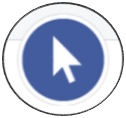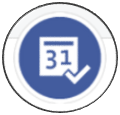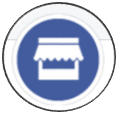
Facebook had recently just turned ten, still in the puberty stage corporate wise but in such a short time had radically changed the face of online interaction and social networking with its more than 1.23 billion, that’s billion, people worldwide. This social network is now worth more than 135 billion dollars, turning in 1.5 billion in profit from its 7.87 billion revenues in 2013 – and Mark Zuckerberg still has to turn 30 years old by May.
That’s how powerful Facebook is, capturing the interest and imagination of millions of active users worldwide. This opened up a great avenue for business owners and digital marketers to market their brands, products and services through the paid advertising Facebook offers, basically providing a platform for digital marketers to reach out to highly targeted audiences and churn out profits.
Facebook’s paid advertising has also gone a long way. From its ad-free existence during its early periods, to offering some of the most innovative digital marketing channels, Facebook has made it easier and more convenient for businesses and digital marketers to reach out and connect with their targeted customers – and Facebook is now making it even better.
Facebook has made some changes to their paid advertising channel focusing on what business would really want to achieve in this social network in the first place – make profits. Selling your products and services right into people’s faces is of course a big no-no and a turn off in social media, so Facebook offers great options other than this that would help businesses achieve their objectives.
Whether you like more brand awareness by getting more likes to your posts, or drive more traffic to your websites or landing pages from the multitude of netizens using Facebook on a daily basis, there will be a Facebook paid advertising model that would fit right into your needs. The following provides a comprehensive guide of what you can be getting from Facebook’s paid advertising and how you can streamline your advertising campaign to fit perfectly well with your end goals.
The key and the first thing that you must know before you start using Facebook’s paid advertising is to know the kind of results that you intend your ads will generate. So read on, choose the paid advertising model that’s right for you – and advertise.
Paid Post Engagement

The News Feeds is a very powerful channel where you can reach and engage with your targeted audiences. You can leverage the power of the News Feeds by creating ads through the Paid Post Engagement objective which you can select when you first create your Facebook ad in the ads manager.
Good for:
- Boosting your Page post in terms of more likes, increase engagement with more comments, wider reach through more shares, more views or plays of your photos and videos, and many more.
- Promoting a recent post that you want to have more readership and exposure, or if you are planning on a new post that you’d like to reach more people as possible in very short time.
- Tailoring your ad with regards to location as it appears in Facebook, either through the news feed or through the right column.
- Tailoring your ad to cater to a particular audience you intended to reach.
- Tailoring your ad according to a particular budget you have set.
Best Practices:
- You can use Paid Post Engagement using the ad manager or you can directly boost a post right from your page’s timeline. You just simply select a post you want to promote, click on boost post, set your budget, select your audience, optimize your bid, place your order – and your ad is ready to go
- It is important that you properly select your audience, whether you’re shooting for a wider reach (but will cost you more) or go for a more targeted audience
- You can simplify your campaign by automatically promoting your most recent post. However, you need to ensure that each post you make is worth promoting or you’ll more of your advertising budgets promoting posts that don’t bring results.
Page Likes

If you’re maintaining a Facebook Page for your brand or business, the most important social signal that you should be gunning for is the Page Like. Choosing this objective category from the Facebook ad manager can help you build a bigger audience for your page by getting more online users to like your page.
Good for:
- Creating better brand awareness by generating more likes for your page. The more likes you generate, the bigger the number of people will become aware of your brand.
- Generating even more likes to your page from targeted audiences. More Page Likes means your Page is popular among Facebook users, which in turn will attract more people to like your page – people who are most likely interested in what your Page has to offer.
- Building a fanbase for a newly created Page.
Best Practices:
- Choose a good image for your ad that will attract the attention of your targeted audiences. Optimum size is 600×22 pixels and you can choose from a photo already in your photo albums or upload a new one. It would be advisable to customize a new image for your ad to generate better results.
- Plan a very compelling headline as well as ad copy that will generate the biggest interest from your targeted audiences and entice them to click on your ads.
- Define the right audience for your ads to ensure that it will reach your targeted audiences.
Clicks to Website

Some business owners and digital marketers prefer generating traffic to their main websites or landing pages instead of their Facebook Pages. They’d rather want their targeted audiences to get right into the heart of the action and make a profitable move, which they can only do so through their landing pages or websites. This paid advertising objective would be just right for you.
Good for:
- Increasing traffic to your website from targeted Facebook users.
- Promoting your websites or landing pages at Facebook without necessarily having or maintaining your own Page.
Best Practices:
- From the Ads manager you can specify whatever URL of your site you wanted to promote after selecting the Clicks to Website option. Depending on what action you want visitors to take, you can either put your main website or your landing page.
- Use a good and compelling image that would go well with your promotion. Ideal image sizes are 600×225 pixels if you choose the News Feed option, or 111×74 pixels if you opt for the side bar.
- Aside from a good image, you should also include a compelling headline and ad copy that will entice targeted audiences to click on your ads – and be directed towards your website or landing pages.
Website Conversions

If you want to go beyond merely generating traffic for your websites or landing pages and actually promote a specific action that your targeted visitors would like to take, then this option would fit right with our needs. It is the same with the Clicks to Website option in a sense, as you need to specify the URL of the site you want to promote, but it involves adding a conversion-tracking pixel that will help you keep track of your conversions results.
Good for:
- Promoting a specific action that your targeted audiences will take when they are directed towards your specified pages.
- Tracking the performance of your ad campaigns in terms of the type of conversion you would like your audiences to take.
Best Practices:
1. Choose the most appropriate conversion-tracking pixel to use depending on your intended customer actions. Pixel types to select from includes:
- Checkouts
- Registrations
- Leads
- Key Web Page Views
- Add to Carts
- Other Web Conversions
2. You should also carefully specify the targeted audience, the budget you have allocated with your ad campaign, and the time frame you intended your campaign would run.
3. It would be best to send targeted audiences to a landing page where their user information can be captured for offline engagement. Sending your targeted audiences to a landing page first before your main website would be very beneficial for you particularly in lead generation.
App Installs

Facebook apps can be one of the more innovative but powerful ways to engage with your targeted audiences.
Good for:
- Promoting an App you’ve created at Facebook or a new one you would like to promote and have Facebook users install
Best Practices:
- Carefully specify the targeted audience, the budget you have allocated with your ad campaign, and the time frame you intended your campaign would run
App Engagement

The success of a Facebook or mobile app is when people install, use and engage in activities that you have featured in your app. The more activities Facebook users engage with your app, the more it increases brand awareness for your business.
Good for:
- Enticing your Facebook app users to engage in more activities that you have featured in your app
Best Practices:
- You can specify where you want targeted audiences to be.
- You can specify the budget and the time duration that you would like your career to run.
- Carefully specify the targeted audience, the budget you have allocated with your ad campaign, and the time frame you intended your campaign would run
Event Responses

Facebook Events is a great way to promote an online or an offline event where you would like Facebook users to attend or engage in. Using this paid advertising option will help you increase attendance to your event.
Good for:
- Increasing the attendance of the event you are promoting through the Facebook events pages
- Promoting your event and get visitors to engage more in what your event is offering.
Best Practices:
- Take careful consideration in the URL of your apps or scripts as this will create more brand awareness and further engagement with your targeted customers.
Offer Claims

One of the better and more innovative ways to create engagement with your targeted audiences is to promote offers that you can create through Facebook. Offers involve getting targeted users to engage in activities which will be rewarded with coupons, discounts and other promotional offers that you would like to give.
Good for:
- Getting your targeted users and people showing up in news feeds to get involved in the promotions you are offering.
Best Practices:
- Carefully target your targeted audiences for your ads so as not to prevent unnecessary expenses that may occur
Conclusion: Facebook is very powerful direct marketing tool that you can use to expose your brand and get more targeted customers. Use these tips outline here and you are on your way of becoming a great Facebook marketer!
Jomer B. Gregorio is a well-rounded expert when it comes digital marketing. Jomer is also known as a semantic SEO evangelist and practitioner. Check out our Digital Marketing Services today and let us help you in achieving positive and profitable results for your business.
